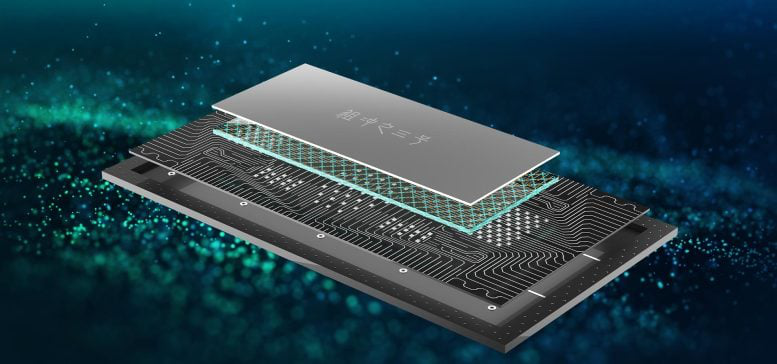博文
中国新型量子机器的运行速度是谷歌的量子机器的100万倍
 精选
精选
||
中国新型量子机器的运行速度是谷歌的量子机器的100万倍
诸平
据《科技日报》(scitechdaily)刊发来自中国科学院(Chinese Academy of Sciences)2025年月日提供的消息,中国的新型量子机器的运行速度是谷歌的量子机器运行速度的100万倍(China’s New Quantum Machine Runs One Million Times Faster Than Google’s)。
Figure 1: Photo of the cryostat holding the Zuchongzhi 3.0 processor.
一项新的量子计算突破在科技界掀起了冲击波。中国科学技术大学(University of Science and Technology of China简称USTC)的研究人员推出了一台105量子比特(105-qubit)的“祖冲之-3号”(Zuchongzhi-3),其计算速度甚至让最强大的超级计算机都相形见绌。(A new quantum computing breakthrough has sent shockwaves through the tech world. Researchers at USTC unveiled Zuchongzhi-3, a 105-qubit machine that processes calculations at speeds that dwarf even the most powerful supercomputers.)
这标志着追求量子霸权的又一次飞跃,该团队展示的计算能力比谷歌的最新结果(Google’s latest results)高出几个数量级。
“祖冲之-3号”在量子计算上的突破(Breakthrough in Quantum Computing with Zuchongzhi-3)
中国科学院下属的中国科学技术大学(USTC)的一个研究小组与其合作伙伴一起,利用配备105个量子比特和182个耦合器的超导量子计算原型“祖冲之-3号”,在随机量子电路采样方面取得了重大进展。
“祖冲之-3号”运行速度惊人,计算速度比目前最强大的超级计算机快1015倍,比谷歌最新公布的量子计算结果快100万倍。这一成就标志着量子计算的重大突破,建立在其前身“祖冲之-2号”(Zuchongzhi-2)的成功基础上。
这项研究由中国科学院院士、中国科学技术大学教授潘建伟(Jianwei Pan),中国科学技术大学教授朱晓波(Xiaobo Zhu,)、彭承志(Chengzhi Peng)和其他机构的研究人员领导,并作为封面文章发表在《物理评论快报》(Physical Review Letters)上——Dongxin Gao, Daojin Fan, Chen Zha, Jiahao Bei, Guoqing Cai, Jianbin Cai, Sirui Cao, Fusheng Chen, Jiang Chen, Kefu Chen, Xiawei Chen, Xiqing Chen, Zhe Chen, Zhiyuan Chen, Zihua Chen, Wenhao Chu, Hui Deng, Zhibin Deng, Pei Ding, Xun Ding, Zhuzhengqi Ding, Shuai Dong, Yupeng Dong, Bo Fan, Yuanhao Fu, Song Gao, Lei Ge, Ming Gong, Jiacheng Gui, Cheng Guo, Shaojun Guo, Xiaoyang Guo, Lianchen Han, Tan He, Linyin Hong, Yisen Hu, He-Liang Huang, Yong-Heng Huo, Tao Jiang, Zuokai Jiang, Honghong Jin, Yunxiang Leng, Dayu Li, Dongdong Li, Fangyu Li, Jiaqi Li, Jinjin Li, Junyan Li, Junyun Li, Na Li, Shaowei Li, Wei Li, Yuhuai Li, Yuan Li, Futian Liang, Xuelian Liang, Nanxing Liao, Jin Lin, Weiping Lin, Dailin Liu, Hongxiu Liu, Maliang Liu, Xinyu Liu, Xuemeng Liu, Yancheng Liu, Haoxin Lou, Yuwei Ma, Lingxin Meng, Hao Mou, Kailiang Nan, Binghan Nie, Meijuan Nie, Jie Ning, Le Niu, Wenyi Peng, Haoran Qian, Hao Rong, Tao Rong, Huiyan Shen, Qiong Shen, Hong Su, Feifan Su, Chenyin Sun, Liangchao Sun, Tianzuo Sun, Yingxiu Sun, Yimeng Tan, Jun Tan, Longyue Tang, Wenbing Tu, Cai Wan, Jiafei Wang, Biao Wang, Chang Wang, Chen Wang, Chu Wang, Jian Wang, Liangyuan Wang, Rui Wang, Shengtao Wang, Xiaomin Wang, Xinzhe Wang, Xunxun Wang, Yeru Wang, Zuolin Wei, Jiazhou Wei, Dachao Wu, Gang Wu, Jin Wu, Shengjie Wu, Yulin Wu, Shiyong Xie, Lianjie Xin, Yu Xu, Chun Xue, Kai Yan, Weifeng Yang, Xinpeng Yang, Yang Yang, Yangsen Ye, Zhenping Ye, Chong Ying, Jiale Yu, Qinjing Yu, Wenhu Yu, Xiangdong Zeng, Shaoyu Zhan, Feifei Zhang, Haibin Zhang, Kaili Zhang, Pan Zhang, Wen Zhang, Yiming Zhang, Yongzhuo Zhang, Lixiang Zhang, Guming Zhao, Peng Zhao, Xianhe Zhao, Xintao Zhao, Youwei Zhao, Zhong Zhao, Luyuan Zheng, Fei Zhou, Liang Zhou, Na Zhou, Naibin Zhou, Shifeng Zhou, Shuang Zhou, Zhengxiao Zhou, Chengjun Zhu, Qingling Zhu, Guihong Zou, Haonan Zou, Qiang Zhang, Chao-Yang Lu, Cheng-Zhi Peng, Xiaobo Zhu, Jian-Wei Pan. Establishing a New Benchmark in Quantum Computational Advantage with 105-qubit Zuchongzhi 3.0 Processor. Physical Review Letters, 2025, 134: 090601. DOI: 10.1103/PhysRevLett.134.090601. Published 3 March, 2025. https://doi.org/10.1103/PhysRevLett.134.090601
参与此项研究的除了来自中国科学技术大学(Hefei National Research Center for Physical Sciences at the Microscale and School of Physical Sciences, University of Science and Technology of China, Hefei, China; Shanghai Research Center for Quantum Science and CAS Center for Excellence in Quantum Information and Quantum Physics, University of Science and Technology of China, Shanghai, China; Hefei National Laboratory, University of Science and Technology of China, Hefei, China)的研究人员之外,还有来自中国合肥的国盾量子科技有限公司(QuantumCTek Co., Ltd., Hefei, China)、中国河南省量子信息与量子密码重点实验室(Henan Key Laboratory of Quantum Information and Cryptography, Zhengzhou, Henan, China)、中国计量科学研究院(National Institute of Metrology, Beijing, China)、中国济南量子技术研究所和合肥国家实验室济南分部(Jinan Institute of Quantum Technology and Hefei National Laboratory Jinan Branch, Jinan, China)、中国西安电子科技大学(School of Microelectronics, Xidian University, Xi’an, China)、中国科学院理论物理研究所(CAS Key Laboratory for Theoretical Physics, Institute of Theoretical Physics, Chinese Academy of Sciences, Beijing, China)的研究人员。
通往量子霸权之路(The Road to Quantum Supremacy)
量子霸权(Quantum supremacy),即量子计算机执行经典计算机无法完成的任务的能力,一直是该领域的关键目标。2019年,谷歌的53量子位Sycamore处理器在200秒内完成了随机电路采样任务,这一壮举在当时世界上最快的超级计算机上估计需要花费1万年时间。
然而,在2023年,中国科技大学的研究人员展示了更先进的经典算法,能够在14秒内完成相同的任务,使用1400多个A100 GPU。随着配备扩展内存的前沿超级计算机的出现,这项任务现在可以在1.6秒内完成,有效地挑战了谷歌早先宣称的量子霸权。
突破边界:九章与祖冲之里程碑(Pushing the Boundaries: Jiuzhang and Zuchongzhi Milestones)
随后,以最优经典算法为基准,中国科技大学的同一个团队在2020年用九章光子量子计算原型机(Jiuzhang photonic quantum computing prototype)实现了第一个严格证明的量子霸权。
随后在2021年使用祖冲之-2号处理器(Zuchongzhi-2 processor)进行了超导演示。
该团队在2023年开发了255个光子的“九章3号”(255-photon Jiuzhang-3),展示了超越传统超级计算机1016个数量级的量子霸权。在2024年10月,谷歌的67量子位超导量子处理器Sycamore,以超过经典超级计算机9个数量级的表现证明了量子霸权。
祖冲之-3号:量子性能的飞跃(Zuchongzhi-3: A Leap in Quantum Performance)
在66量子位的祖冲之-2号的基础上,中国科技大学的研究团队显著提高了关键性能指标,以开发具有105量子位和182个耦合器的祖冲之-3号。该量子处理器的相干时间为72 μs,同时单量子比特门保真度为99.90%,同时双量子比特门保真度为99.62%,同时读出保真度为99.13%。延长的相干时间为执行更复杂的操作和计算提供了必要的持续时间。
为了评估其能力,该团队在系统上进行了一个83量子位,32层随机电路采样任务。结果显示,计算速度比世界上最强大的超级计算机快15个数量级,比谷歌最新的量子计算结果快6个数量级,在超导系统中建立了迄今为止最强大的量子计算优势。
拓展量子研究的未来(Expanding the Future of Quantum Research)
继“祖冲之-3号”取得最强量子计算优势后,该团队正在积极推进量子纠错、量子纠缠、量子模拟和量子化学等方面的研究。研究人员已经实现了二维网格量子比特架构,提高了量子比特的互连性和数据传输速率。
利用这种架构,他们集成了表面代码,目前正在使用距离7的表面代码开发量子纠错,并计划将其扩展到距离9和11。这些努力旨在实现量子比特的大规模集成和操作。
全球认可及影响(Global Recognition and Impact)
该团队的工作意义深远,受到了广泛的赞誉。一位期刊审稿人将其描述为“对新型超导量子计算机的基准测试,该计算机显示了最先进的性能,”并且“比之前的66量子位设备(Zuchongzhi-2)有了重大升级。”
与此同时,《物理》(Physics)杂志专门刊登了加拿大卡尔加里大学量子科学与技术研究所(Institute for Quantum Science and Technology, University of Calgary, Calgary, Canada)巴里·桑德斯(Barry C. Sanders)评议性文章,对该研究的创新进行了深入探讨,并强调了其更广泛的意义。原文详见:Barry C. Sanders. Superconducting Quantum Computing Beyond 100 Qubits. Physics,2025, 18: 45. Epub. March 3, 2025. https://physics.aps.org/articles/v18/45
上述介绍仅供参考,欲了解更多信息敬请注意浏览原文和相关报道。
我国成功研制超导量子计算原型机“祖冲之三号”实现超导体系“量子计算优越性”新纪录.中国科学报发布时间:2025-03-04
In the relentless pursuit of quantum computational advantage, we present a significant advancement with the development of Zuchongzhi 3.0. This superconducting quantum computer prototype, comprising 105 qubits, achieves high operational fidelities, with single-qubit gates, two-qubit gates, and readout fidelity at 99.90%, 99.62%, and 99.13%, respectively. Our experiments with an 83-qubit, 32-cycle random circuit sampling on the Zuchongzhi 3.0 highlight its superior performance, achieving 1×106 samples in just a few hundred seconds. This task is estimated to be infeasible on the most powerful classical supercomputers, Frontier, which would require approximately 5.9×109 yr to replicate the task. This leap in processing power places the classical simulation cost 6 orders of magnitude beyond Google’s SYC-67 and SYC-70 experiments [Morvan et al., Nature 634, 328 (2024)], firmly establishing a new benchmark in quantum computational advantage. Our work not only advances the frontiers of quantum computing but also lays the groundwork for a new era where quantum processors play an essential role in tackling sophisticated real-world challenges.
https://blog.sciencenet.cn/blog-212210-1476580.html
上一篇:3.8妇女节的礼物:不是鲜花而是女性健康辅修课
下一篇:Free eBook1:《药物发现史》简介

